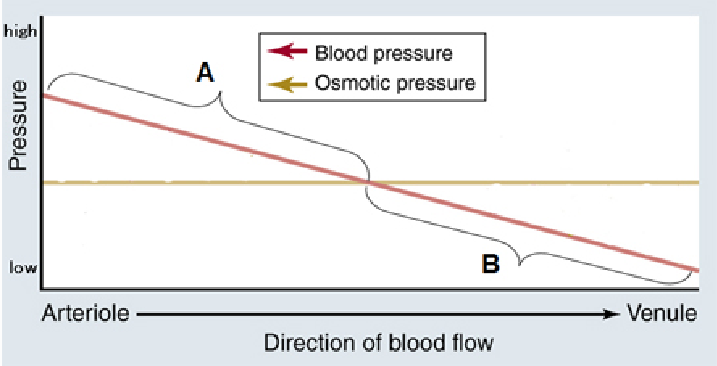The graph below can be used to understand the forces underlying the movement of fluid between the blood and the interstitial fluid. What is a true statement concerning these processes?

A. Normally, the net amount of fluid flow in region A is less than the net amount of fluid flow in region B.
B. Sodium ions contribute significantly to the movement of fluid in region B.
C. Fluid leaves the blood in region A and returns to the blood in region B.
D. In people suffering from severe liver disease or protein starvation, the fluid flow in region B is increased.
E. Edema results from reduction of fluid flow in region A.
Clarify Question
What is the key concept addressed by the question?
What type of thinking is required?
Gather Content
What do you already know about the movement of materials in and out of the circulatory system? What other information is related to the question?
Choose Answer
Given what you now know, what information is most likely to produce the correct answer?
Reflect on Process
Did your problem-solving process lead you to the correct answer? If not, where did the process break down or lead you astray? How can you revise your approach to produce a more desirable result?
C. Fluid leaves the blood in region A and returns to the blood in region B.
Clarify Question
What is the key concept addressed by the question?
· This question is asking you to interpret a graph that shows the movement of materials in and out of the blood.
What type of thinking is required?
· Analyze level (sample phrases, or use your own):
o This is an analyze question because you have to break pressure and blood flow into their component pieces to understand how they function.
Gather Content
What do you already know about the movement of materials in and out of the circulatory system? What other information is related to the question?
· A solution is made of dissolved particles (solute) and a liquid component (solvent).
· Where there is more solute, there proportionally is less solvent.
· Osmosis is the movement of a liquid (solvent) from high to low concentration of that liquid.
· Osmotic pressure is the tendency of a solution to allow water to flow in water via osmosis.
· Osmotic pressure increases as solute concentration increases and solvent concentration decreases.
· Through osmosis, fluid leaves the circulatory system near the arteriole ends of capillaries, and returns to the blood near the venular side of capillaries.
Choose Answer
Given what you now know, what information is most likely to produce the correct answer?
· In region A, the osmotic pressure is lower than the blood pressure. Where osmotic pressure is lower, solute concentration is lower, and there is a higher concentration of fluid. Fluid moves from an area of high concentration to low concentration. Therefore, fluid flows out of the arterioles, where fluid concentration is higher, toward the tissues.
· In region B, the opposite is true. Osmotic pressure is higher than the blood pressure in the circulatory system, which means there is proportionally less fluid. Fluid flows form high concentration to low concentration, so the net movement would be into the blood.
Reflect on Process
Did your problem-solving process lead you to the correct answer? If not, where did the process break down or lead you astray? How can you revise your approach to produce a more desirable result?
· Analyze level:
o Answering this question correctly depended not only on distinguishing between osmotic pressure and solvent concentration, but on your ability to break down, or analyze, osmosis. If you got an incorrect answer, did you remember that components of osmosis include the movement of fluid from high concentration to low concentration, or that as osmotic pressure increases, fluid concentration decreases? Did you have trouble breaking down the osmotic pressure to determine the correct answer?
You might also like to view...
At the emergency room, the doctor tell you "Your friend has high levels of troponin in the blood." What is this likely to indicate?
A. A broken bone B. A high level of fitness C. An unhealthy diet D. Muscle damage
The folds of the stomach are called
a. villi. b. microvilli. c. tight junctions. d. rugae. e. haustra.
A(n) ________ model of community structure assumes that the presence and absence of individual species in a community result from independent responses to the physical environment and interactions among species have no impact on community structure
Fill in the blank(s) with correct word
Which genus contains the nitrogen-fixing bacteria that live in legume nodules?
A) Bacillus B) Escherichia C) Rhizobium D) Vibrio